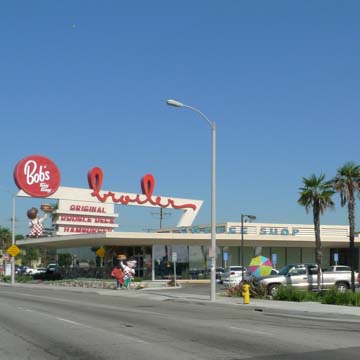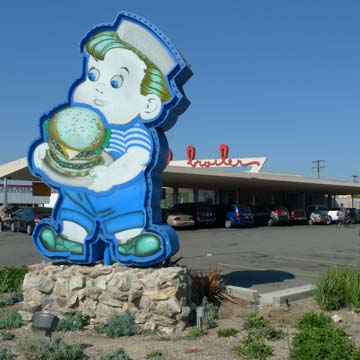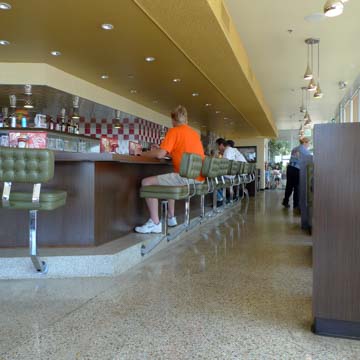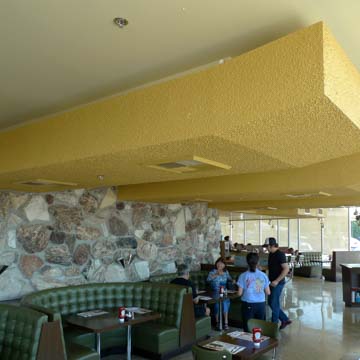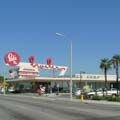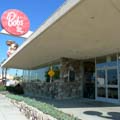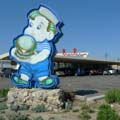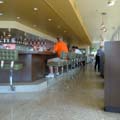Bob’s Big Boy Broiler
Bob’s Big Boy Broiler in Downey, California, is a building with a turbulent history. Built in 1958 to a design by architect Paul B. Clayton, it was originally named Harvey’s Broiler, after its then owner Harvey Ortner. In 1966, it was sold and renamed Johnie’s Broiler. It continued to operate as a restaurant until 2001, when it was again sold and converted into a car dealership. In 2007, its leaseholder began an illegal demolition of the building, which was only halted after concerned members of the public alerted the police. Following a campaign to save the building, much of which now stood in ruins, the Bob’s Big Boy restaurant chain agreed to purchase the site and rebuild the Broiler according to Clayton’s original drawings. The newly restored building reopened in 2009, and today stands as a landmark example of Googie architecture.
Situated at a bend on a busy three-lane highway, the building is visible to motorists approaching from either direction. Seeking to capitalize on this prominent location, Clayton planted an extravagant sign, measuring 68 feet wide and 18 feet high, on the roof of the building. The sign is, in fact, more elaborate than the architecture of the restaurant, a design decision that Clayton later explained was a result of a limited budget. As architecture critic Reyner Banham wrote in his treatise on Los Angeles, “it makes financial sense to put up relatively simple single-story boxes, and then make them tall enough to attract attention by piling up symbols and graphic art on top.” At the Broiler, these symbols are mounted on a steel pylon folded into the shape of an elongated “7.” This pylon, which rises through the center of the restaurant’s roof, carries the word “broiler” in looping cursive letters, illuminated at night in red neon. The original block lettering that once read “Harvey’s” and, later, “Johnie’s” has been replaced by the circular logo of Bob’s Big Boy, beneath which revolves a statue of the chain’s ubiquitous Big Boy mascot. The updated sign and addition of the mascot were two of the very few alterations made to Clayton’s design during the rebuild. Additional support is provided to the long cantilever of this towering sign by a wide column featuring backlit lettering. Originally, this lettering described the establishment as a “Restaurant, Coffee Shop, Drive-In.” Today, it advertises the “Original Double Deck Hamburger,” a fiberglass model of which is held aloft by the rotating mascot. The sign is not only an advertising tool, but also performs a structural function; its pylon penetrates the restaurant below and anchors it to the ground, acting as a steel pin to prevent lateral movement of the building during earthquakes.
The building itself is a simple flat-roofed structure, originally featuring full-height glazed facades that terminated in pillars of Palo Verde stone. In the dining area, which has a capacity of 110, customers are seated either in booths, at dining tables, or on cantilevered stools at the long counter. To avoid cluttering the roofline and obscuring the sign, all ventilation ductwork was contained within the dining area, disguised as a series of painted ribs suspended below the ceiling. In the parking lot, which can accommodate up to 350 cars, the wide canopy surrounding the coffee shop veers away from the main structure to form a covered walkway with a V-shaped roofline. This 240-foot-long walkway is bordered by 98 parking bays where in-car service was once offered, with carhops roller skating back and forth to take orders and deliver food.
In its heyday, the Broiler was a thriving hub of the burgeoning car culture in Los Angeles. Due to the expansive size of its parking lot, it was a particularly popular spot for cruising. In his article The Hair Boys, journalist Tom Wolfe discussed this practice in detail, describing how teenagers would “cruise around in their cars in Harvey’s huge parking lot, boys and girls, showing each other the latest fashions in cars, hairdos (male and female) and clothes.” At its peak, Harvey’s would regularly play host to over 1,000 cars over the course of a single night, with drivers queuing along surrounding roads for their turn to cruise the lot. Though Harvey’s has now become Bob’s Big Boy Broiler, the restaurant continues to uphold this tradition, honoring its automotive legacy with a weekly cruise night. That the building remains both standing and operational today is only due to the efforts of those who campaigned for its preservation. Its near demise and subsequent rebirth have secured its place in architectural history and sealed its status as a cultural icon.
References
“Bob’s Big Boy Broiler.” Los Angeles Conservancy. Accessed March 25, 2018. https://www.laconservancy.org/.
Hess, Alan. Googie Redux: Ultramodern Roadside Architecture. San Francisco: Chronicle Books, 2004.
Perdomo, Daniela. “Getting fired up over Johnie’s Broiler.” Los Angeles Times, December 23, 2007.
Wolfe, Tom. The Pump House Gang. London: Black Swan, 1989.
Writing Credits
If SAH Archipedia has been useful to you, please consider supporting it.
SAH Archipedia tells the story of the United States through its buildings, landscapes, and cities. This freely available resource empowers the public with authoritative knowledge that deepens their understanding and appreciation of the built environment. But the Society of Architectural Historians, which created SAH Archipedia with University of Virginia Press, needs your support to maintain the high-caliber research, writing, photography, cartography, editing, design, and programming that make SAH Archipedia a trusted online resource available to all who value the history of place, heritage tourism, and learning.














